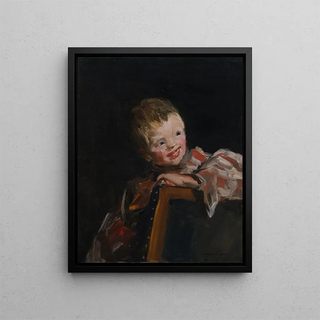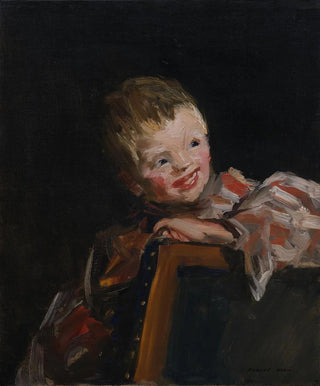Art print | Cory Cori looking over the back of a chair - Robert Henri


View from behind

Frame (optional)
The artwork "Cory Cori looking over the back of a chair" by Robert Henri is a piece that transcends the simple frame of a canvas to immerse us in the intimacy of a fleeting moment. This delicate and lively depiction of a young woman, frozen in a moment of contemplation, evokes deep emotions and invites reflection. Henri, master of realism, manages to capture not only the appearance of his model but also the very essence of her state of mind. Observing this piece, the viewer is transported to a space where time seems suspended, where each brushstroke tells a story. The soft light enveloping Cory Cori's figure adds an almost ethereal dimension to this scene, enhancing the atmosphere of tranquility and gentleness.
Style and uniqueness of the work
Robert Henri's style is characterized by a bold and expressive approach, which is fully evident in this piece. The brush technique, both fluid and precise, allows for the creation of rich textures that bring the painting to life. The colors, subtly nuanced, vibrate with an intensity that captures the eye and draws attention to the main subject. Henri does not merely reproduce reality; he interprets it, injecting a sensitivity that makes each artwork unique. In "Cory Cori looking over the back of a chair," the posture of the young woman, slightly leaning forward, suggests curiosity, introspection that resonates with anyone who has ever felt the need to escape into their thoughts. This painting is an invitation to contemplation, a moment of pause in a often restless world.
The artist and his influence
Robert Henri, an iconic figure of the American realist movement, knew how to mark his era with his innovative artistic vision. By moving away from the academic conventions of his time, he paved the way for new artistic currents that favored personal expression and the depiction of everyday life. Henri was a passionate advocate for the work of artists outside elitist circles, encouraging everyone to find their own voice. His influence is felt not only in his own works, but

Matte finish

View from behind

Frame (optional)
The artwork "Cory Cori looking over the back of a chair" by Robert Henri is a piece that transcends the simple frame of a canvas to immerse us in the intimacy of a fleeting moment. This delicate and lively depiction of a young woman, frozen in a moment of contemplation, evokes deep emotions and invites reflection. Henri, master of realism, manages to capture not only the appearance of his model but also the very essence of her state of mind. Observing this piece, the viewer is transported to a space where time seems suspended, where each brushstroke tells a story. The soft light enveloping Cory Cori's figure adds an almost ethereal dimension to this scene, enhancing the atmosphere of tranquility and gentleness.
Style and uniqueness of the work
Robert Henri's style is characterized by a bold and expressive approach, which is fully evident in this piece. The brush technique, both fluid and precise, allows for the creation of rich textures that bring the painting to life. The colors, subtly nuanced, vibrate with an intensity that captures the eye and draws attention to the main subject. Henri does not merely reproduce reality; he interprets it, injecting a sensitivity that makes each artwork unique. In "Cory Cori looking over the back of a chair," the posture of the young woman, slightly leaning forward, suggests curiosity, introspection that resonates with anyone who has ever felt the need to escape into their thoughts. This painting is an invitation to contemplation, a moment of pause in a often restless world.
The artist and his influence
Robert Henri, an iconic figure of the American realist movement, knew how to mark his era with his innovative artistic vision. By moving away from the academic conventions of his time, he paved the way for new artistic currents that favored personal expression and the depiction of everyday life. Henri was a passionate advocate for the work of artists outside elitist circles, encouraging everyone to find their own voice. His influence is felt not only in his own works, but






